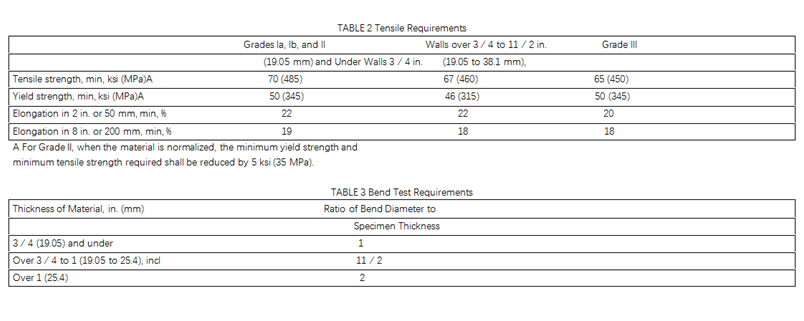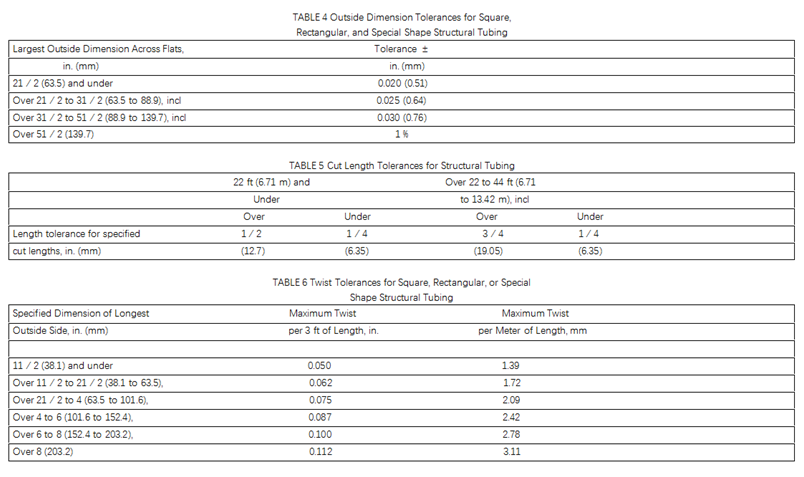

1. Scope 1.1 This specification covers grades of hot-formed welded and seamless high-strength low-alloy square, rectangular, round, or special shape structural tubing for welded, riveted, or bolted construction of bridges and buildings and for general structural purposes. When the steel is used...
Online Inquiry
1. Scope
1.1 This specification covers grades of hot-formed welded and seamless
high-strength low-alloy square, rectangular, round, or special shape
structural tubing for welded, riveted, or bolted construction of bridges and
buildings and for general structural purposes. When the steel is used in
welded construction, the welding procedure shall be suitable for the steel
and the intended service.
1.2 Grade II has atmospheric corrosion resistance equivalent to that of
carbon steel with copper (0.20 minimum Cu) Grades Ia and Ib have
atmospheric corrosion resistance substantially better than that of Grade II
(Note 1). When properly exposed to the atmosphere, Grades Ia and Ib can be
used bare (unpainted) for many applications. When enhanced corrosion
resistance is desired, Grade III, copper limits may be specified.
NOTE 1—For methods of estimating the atmospheric corrosion resistance of
low alloy steels see Guide G 101 or actual data.
1.3 The values stated in inch-pound units are to be regarded as the
standard.
2. Referenced Documents
2.1 ASTM Standards:
A 370 Test Methods and Definitions for Mechanical Testing of Steel
Products2
A 700 Practices for Packaging, Marking, and Loading Methods for Steel
Products for Domestic Shipment3
A 751 Test Methods, Practices, and Terminology for Chemical Analysis of
Steel Products2
G 101 Guide for Estimating the Atmospheric Corrosion Resistance of
Low-Alloy Steels4
3. Ordering Information
3.1 Orders for material under this specification should include the
following as required to describe the material adequately:
3.1.1 Quantity (feet or number of lengths),
3.1.2 Grade (Table 1 and Table 2),
3.1.3 Material (round, square, or rectangular tubing),
3.1.4 Method of manufacture (seamless, buttwelded, or hot-stretch-reduced
electric-resistance welded),
3.1.5 Size (outside diameter and nominal wall thickness for round tubing
and the outside dimensions and calculated nominal wall thickness for
square and rectangular tubing),
3.1.6 Length (specific or random, see 8.2),
3.1.7 End condition (see 9.2),
3.1.8 Burr removal (see 9.2),
3.1.9 Certification (see 12.1),
3.1.10 Specification designation,
3.1.11 End use, and
3.1.12 Special requirements.
4. Process
4.1 The steel shall be made by one or more of the following processes:
open-hearth, basic-oxygen, or electric-furnace.
4.2 Steel may be cast in ingots or may be strand cast. When steels of
different grades are sequentially strand cast, identification of the
resultant transition material is required. The
producer shall remove the transition material by any established procedure
that positively separates the grades.
5. Manufacture
5.1 The tubing shall be made by the seamless,
furnacebuttwelded (continuous-welded), or
hot-stretch-reduced electric-resistance-welded process.


